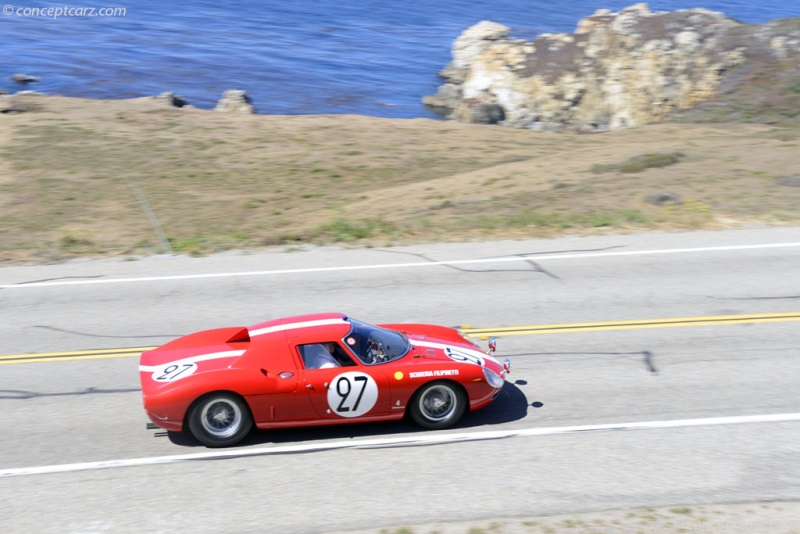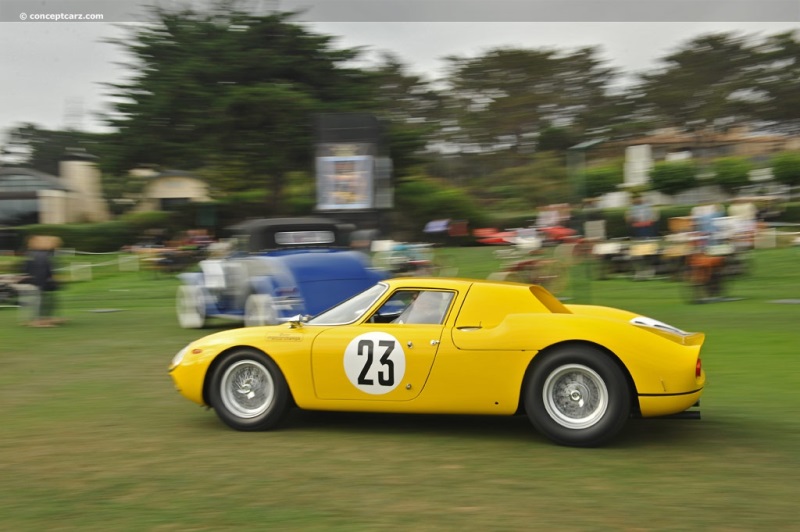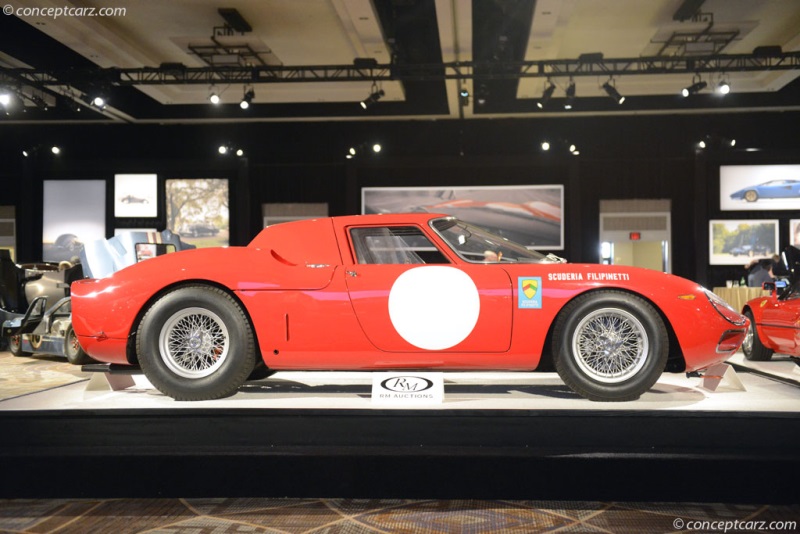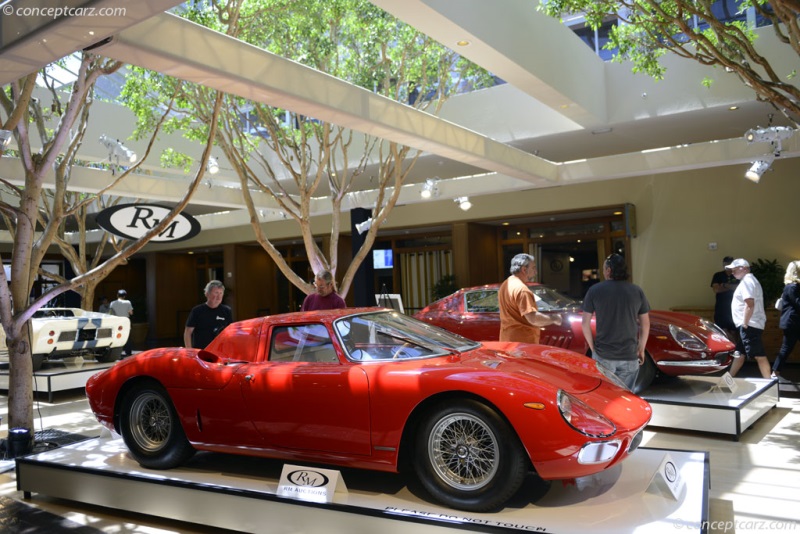Ferrari entered the burgeoning mid/rear-engine sports car arena with its 246 SP model, and continual development birthed more advanced iterations of the Dino V6, but it was consistently outclassed by its larger-engined competitors. Ferrari's racing pedigree had been built atop its twelve-cylinder engines, so the installation of a rear-placed V12 was a logical consideration. In 1963, a 246 SP (chassis number 0796) was fitted with a three-liter Colombo short-block engine, birthing the 250 P racecar. Tuned to Testa Rossa specification and wearing open coachwork, it would claim victory at the 24 Hours of Le Mans that year. 
Coupe
Chassis #: 5903
View info and historyAt the Paris Salon in 1963, Ferrari unveiled a new GT class model (chassis number 5149) dubbed the 250 LM (commemorating its victory at Le Mans). It wore Berlinetta coachwork built by Sergio Scaglietti with a low roof, curvaceous bodylines, and flying buttress edges. Mounted mid-ship was the 250 GT engine that had been in use for the past decade.Equipped with the 250 GT engine and using the '250' nomenclature, Ferrari hoped the 250 LM would be included under the homologation umbrella met by previous 250 GT models. Bolstering the credence that the 250 LM was a regular road-going production car, Maranello gave it spare wheels, horns, and even printed sales brochures.The FIA's Commission Sportive Internationale (CSI) was not convinced, arguing that the relocation of the engine from the front to the back made the 250 LM a new model, and thus, homologation requirements would need to be met. Ferrari had somehow managed to qualify its 250 GTO, of which only 37 were produced, for GT competition by claiming that it was simply a re-bodied 250 SWB. Denied homologation for production-based racing by the CSI, Ferrari would have to build and sell a hundred examples of its 250 LM to meet class rules. It was approved to race in the Prototype class, but this meant it would have to compete against much larger-displacement models, including the company's own P2 Spider. 
Coupe
Chassis #: 5909
View info and historyFerrari won the International Championship for GT Manufacturers in both 1962 and 1963 in the over-two-liter category with its 250 GTO. Adjustments made by the FIA for the 1964 season resulted in classes that were essentially 'under two liters' and 'over two liters.' With the 250 LM denied homologation status, the 250 GTO was called back into service, where it would compete against stiff competition from the larger capacity lightweight Jaguar E-Types, Aston Martin DB4 GT/Project cars, and the AC Cobras. Enraged by the FIA's decision, Enzo Ferrari temporarily withdrew his entrant's license; instead, the 250 LMs were sold to privateers who raced them from 1964 through 1967. The list of private teams that competed with the 250 LM includes Luigi Chinetti's North American Racing Team, Maranello Concessionaires, the Scuderia Filipinetti, and the Garage Francorchamps.Mid-Engine Revolution
The early-to-mid 1960s were transitional years for motorsports, as many entrants transitioned to mid- or rear-engine configuration. During the 1964 Le Mans race, over half the entrants used mid- or rear-engine configuration, and nearly half were powered by 3-liter or larger engines. With performance reaching new levels, it put a strain on mechanical components, particularly transmission and clutches, with many unable to cope with the power. Approximately thirty examples retired and twenty-four competitors finished the 1964 Le Mans race.
Coupe
Chassis #: 5899 GT
Engine #: 5899
View info and history
Auction entries : 1Although down in power and displacement compared to many competitors, the engine powering the 250 LM had endured many years of constant development, ensuring an unsurpassed level of reliability. This proved paramount at several races, including the twenty-four-hour endurance event, where the relentless strain quickly revealed every component's breaking point. At the Rheims 12 Hours of July 5, 1964, Graham Hill and Jo Bonnier drove the 250 LM of Maranello Concessionaire to victory. The 250 LM's finest accomplishment was in 1965, when it outlasted and outpaced the entire field to claim victory.1965 24 Hours of Le Mans
For the 1965 Le Mans race, Ford engines powered eleven of the entries and Ferrari had no fewer than twelve cars on the grid. Ford was favored to win, but its biggest competitor was reliability, leaving Ferrari to claim victory. Ferraris at the 1965 Le Mans
Having vowed to pull his SEFAC Ferrari works team out of the GT Championship, the five 250 LM cars entered in the 1965 24 Hours of Le Mans were by customer teams. Masten Gregory and Jochen Rindt drove for NART (1st Overall), Lucien Bianchi and Mike Salmon for Maranello Concessionaires (retired after 99 laps due to gearbox issues), Dieter Spoerry and Armand Boller for Scuderia Filipinetti (6th Overall), and Pierre Dumay and Gustave Gosselin for Pierre Dumay (2nd Overall). Willy Mairesse and Jean Blaton drove for Ecurie Francorchamps and retired after 146 laps due to clutch issues. Ecurie Francorchamps had a reserve 250 LM (race number 63) which did not race.
Coupe
Chassis #: 6119
View info and historyFerrari (SpA Dino SEFAC) raced a new Dino prototype, the 166 P, equipped with a 1.6-liter V6 engine. Driven by Giancarlo Baghetti (co-driver Mario Casoni), it quickly retired after two laps due to engine issues.Designed by Mauro Forghieri, the new P2 design was ready by the April test weekend. Known as the 275 P2 and 330 P2, these models had lighter and lower chassis with more aerodynamic coachwork. The four camshaft 3.3-liter V12 engine delivered 350 horsepower in 275 P2 configuration and 410 horsepower in the 4.0-liter 330 P2. The 275 P2 claimed victory at the 1000 km of Monza (chassis 0836 / Mike Parkes/Jean Guichet) and the Targa Florio (0828 / Nino Vaccarella/Lorenzo Bandini). The 330 P2 was victorious at the Nurburgring 1000 km (0828) and the 12 Hours Reims (either chassis 0836 or 0838). For the 1966 season, the P2 was replaced by the P3. At Le Mans, NART placed 7th with Pedro Rodríguez and Nino Vaccarella driving a 365 P2 Spyder. It was powered by a single overhead camshaft, 4.4-liter V12 engine. Mike Parkes and Jean Guichet drove a 330 P2 Spyder for SpA Ferrari SEFAC, completing 315 laps before retiring in the 23 hour due to gearbox issues. John Surtees and Ludovico Scarfiotti (team SpA Ferrari SEFAC) completed 18 hours and 225 laps before gearbox sidelined their 330 P2 Spyder. Lorenzo Bandini and Giampiero Biscaldi (SpA Ferrari SEFAC) drove their 275 P2 for 221 laps (17 hours) before retirement. The 365 P2 entered by Maranello Concessionaires Ltd. and driven by David Pier and Jo Bonnier lasted 101 laps (9 hours) before ignition issues forced retirement. Ferrari 250 LM at the 1965 Le Mans
Five different Ferrari 250 LM examples were entered by an assortment of private teams in 1965 at Le Mans, and at the close of the 24 hours, the NART-entered chassis number 5893 driven by Masten Gregory and Jochen Rindt had finished first, earning Ferrari its sixth consecutive Le Mans victory. The pair completed 347 laps of the 8.365-mile circuit, averaging 120.944 mph for the 24 hours. This would be Maranello's final overall victory at the 24 Hours of LeMans until 2003 when the Ferrari 499P earned its place at the top of the podium. The 250 LM also claimed second and sixth place, and a Ferrari 275 GTB in 3rd. This was also the first non-works team victory (NART) since Ecurie Ecosse in 1957 and the first international race victory for Goodyear tires. Controversy
Denied homologation was certainly problematic and upsetting for Enzo Ferrari, but this was not the end of its drama. It did cross the finish line before every other car at the 1965 Le Man's race, but did it really win per the letter of the law? If the legend is true, then no, it did not. Reportedly, the reserve driver, Ed Hugus, drove a shift in the winning 250 LM. Gregory pitted unexpectedly just before dawn, and when Rindt could not be found, Hugus was tasked with driving. According to regulations, Gregory could not drive again once Hugus got behind the wheel. Since Gregory did drive again, the car should have been disqualified.
Coupe
Chassis #: 5893
View info and historyWhy was it allowed? Hugus was not recorded and was never officially credited with co-driving. He never made public claims about this story, and the story lay dormant until the late 2000s. It remains unknown if it is accurate or fiction. 250 LM Production and Nomeclature
Ferrari built thirty-two examples of the 250 LM chassis from 1963 to 1965. The first chassis, 5149 (the Paris Auto Show car), received a 250 P engine, while all subsequent examples received the 3.3-liter engines as used in the 275 P. Thus, by Ferrari naming convention, the 250 LM should be designated '275 LM.' It used the '250' designation to facilitate the homologation process.250 LM Specification
The 250 LM had a tubular space frame chassis with a fully independent double wishbones suspension with front and rear unequal-length wishbones, coil springs, telescopic shock absorbers, and anti-roll bars. It had a wheelbase size of 94.4 inches, a rack and pinion steering system, and four-wheel disc brakes. The 3,286cc aluminum block V-12 engine breathed through six Weber 38 DCN carburetors and delivered approximately 320 horsepower. It was paired with a five-speed manual transmission which delivered power to the rear wheels.
Coupe
Chassis #: 5909
View info and historyWith the mid-engine configuration, the artisans at Scaglietti were able to craft the bodywork around the chassis in a heretofore unseen manner, with a low and aerodynamic stance that complimented the vehicle's state-of-the-art mechanical specification. Standing just under 44 inches tall, the voluptuous bodywork incorporated design elements from the company's past, including covered headlights and a kammback tail. Le Mans Victories
1960 : Scuderia Ferrari (drivers Olivier Gendebien and Paul Frère) Ferrari 250 TR59/60
1961 : SEFAC Ferrari (drivers Olivier Gendebien and Phil Hill) Ferrari 250 TRI/61
1962 : SEFAC Ferrari (drivers Olivier Gendebien and Phil Hill) Ferrari 330 TRI/LM
1963 : SpA Ferrari SEFAC (drivers Ludovico Scarfiotti and Lorenzo Bandini) Ferrari 250 P
1964 : SpA Ferrari SEFAC (Nino Vaccarella and Jean Guichet) Ferrari 275 P
1965 : North American Racing Team (Masten Gregory and Jochen Rindt) Ferrari 250 LM
by Daniel Vaughan | Jul 2023
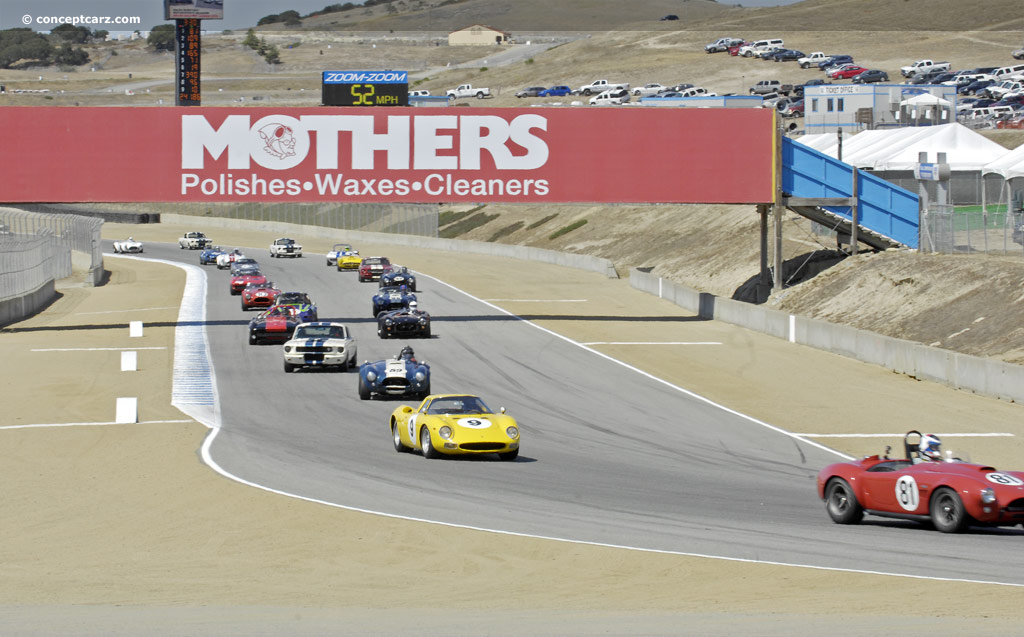
Coupe
Chassis #: 5903
View info and history

Coupe
Chassis #: 5909
View info and history
The early-to-mid 1960s were transitional years for motorsports, as many entrants transitioned to mid- or rear-engine configuration. During the 1964 Le Mans race, over half the entrants used mid- or rear-engine configuration, and nearly half were powered by 3-liter or larger engines. With performance reaching new levels, it put a strain on mechanical components, particularly transmission and clutches, with many unable to cope with the power. Approximately thirty examples retired and twenty-four competitors finished the 1964 Le Mans race.
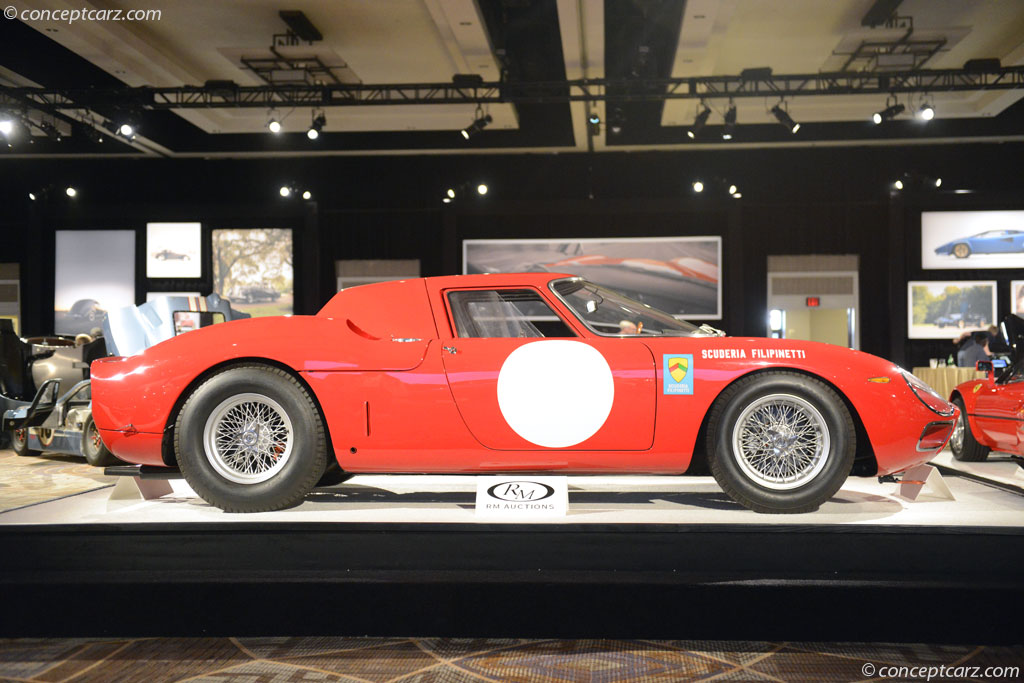
Coupe
Chassis #: 5899 GT
Engine #: 5899
View info and history
Auction entries : 1
For the 1965 Le Mans race, Ford engines powered eleven of the entries and Ferrari had no fewer than twelve cars on the grid. Ford was favored to win, but its biggest competitor was reliability, leaving Ferrari to claim victory. Ferraris at the 1965 Le Mans
Having vowed to pull his SEFAC Ferrari works team out of the GT Championship, the five 250 LM cars entered in the 1965 24 Hours of Le Mans were by customer teams. Masten Gregory and Jochen Rindt drove for NART (1st Overall), Lucien Bianchi and Mike Salmon for Maranello Concessionaires (retired after 99 laps due to gearbox issues), Dieter Spoerry and Armand Boller for Scuderia Filipinetti (6th Overall), and Pierre Dumay and Gustave Gosselin for Pierre Dumay (2nd Overall). Willy Mairesse and Jean Blaton drove for Ecurie Francorchamps and retired after 146 laps due to clutch issues. Ecurie Francorchamps had a reserve 250 LM (race number 63) which did not race.

Coupe
Chassis #: 6119
View info and history
Five different Ferrari 250 LM examples were entered by an assortment of private teams in 1965 at Le Mans, and at the close of the 24 hours, the NART-entered chassis number 5893 driven by Masten Gregory and Jochen Rindt had finished first, earning Ferrari its sixth consecutive Le Mans victory. The pair completed 347 laps of the 8.365-mile circuit, averaging 120.944 mph for the 24 hours. This would be Maranello's final overall victory at the 24 Hours of LeMans until 2003 when the Ferrari 499P earned its place at the top of the podium. The 250 LM also claimed second and sixth place, and a Ferrari 275 GTB in 3rd. This was also the first non-works team victory (NART) since Ecurie Ecosse in 1957 and the first international race victory for Goodyear tires. Controversy
Denied homologation was certainly problematic and upsetting for Enzo Ferrari, but this was not the end of its drama. It did cross the finish line before every other car at the 1965 Le Man's race, but did it really win per the letter of the law? If the legend is true, then no, it did not. Reportedly, the reserve driver, Ed Hugus, drove a shift in the winning 250 LM. Gregory pitted unexpectedly just before dawn, and when Rindt could not be found, Hugus was tasked with driving. According to regulations, Gregory could not drive again once Hugus got behind the wheel. Since Gregory did drive again, the car should have been disqualified.
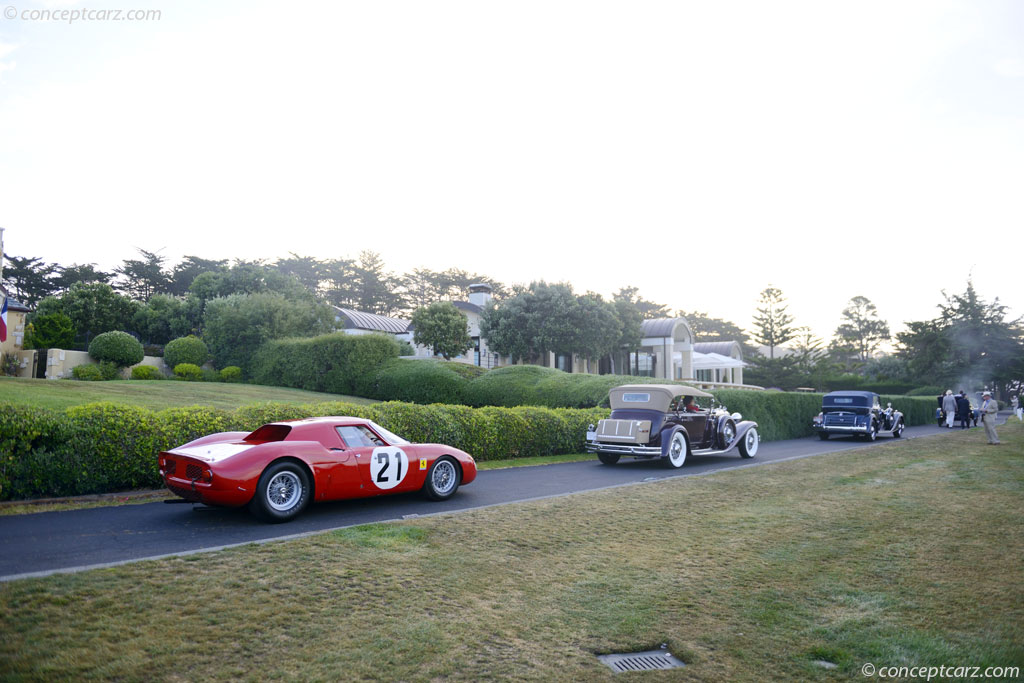
Coupe
Chassis #: 5893
View info and history
Ferrari built thirty-two examples of the 250 LM chassis from 1963 to 1965. The first chassis, 5149 (the Paris Auto Show car), received a 250 P engine, while all subsequent examples received the 3.3-liter engines as used in the 275 P. Thus, by Ferrari naming convention, the 250 LM should be designated '275 LM.' It used the '250' designation to facilitate the homologation process.250 LM Specification
The 250 LM had a tubular space frame chassis with a fully independent double wishbones suspension with front and rear unequal-length wishbones, coil springs, telescopic shock absorbers, and anti-roll bars. It had a wheelbase size of 94.4 inches, a rack and pinion steering system, and four-wheel disc brakes. The 3,286cc aluminum block V-12 engine breathed through six Weber 38 DCN carburetors and delivered approximately 320 horsepower. It was paired with a five-speed manual transmission which delivered power to the rear wheels.
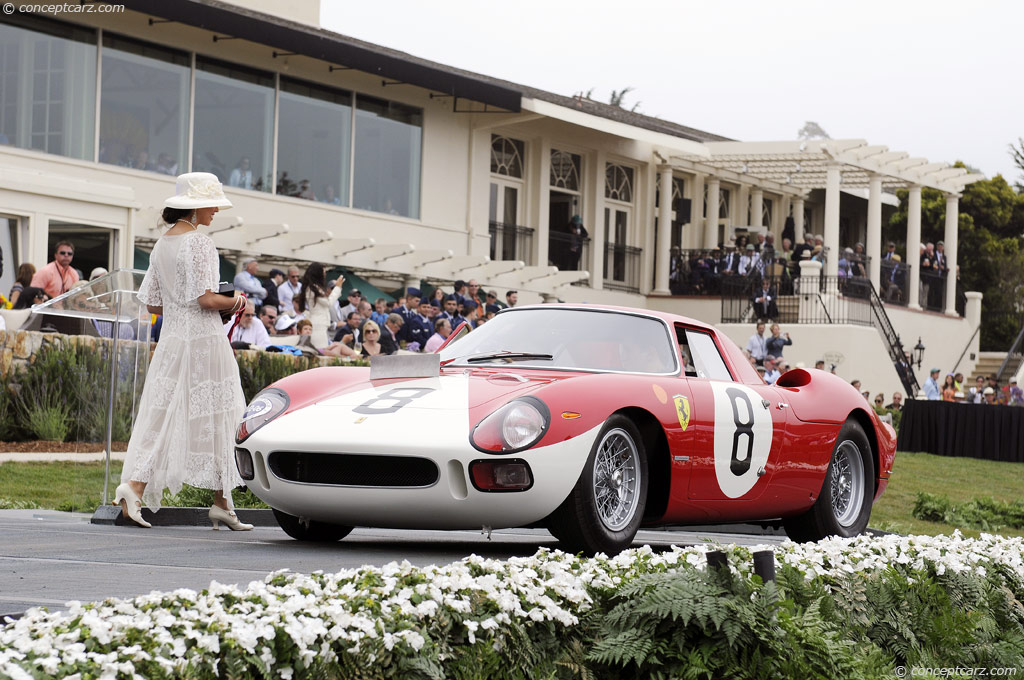
Coupe
Chassis #: 5909
View info and history
1960 : Scuderia Ferrari (drivers Olivier Gendebien and Paul Frère) Ferrari 250 TR59/60
1961 : SEFAC Ferrari (drivers Olivier Gendebien and Phil Hill) Ferrari 250 TRI/61
1962 : SEFAC Ferrari (drivers Olivier Gendebien and Phil Hill) Ferrari 330 TRI/LM
1963 : SpA Ferrari SEFAC (drivers Ludovico Scarfiotti and Lorenzo Bandini) Ferrari 250 P
1964 : SpA Ferrari SEFAC (Nino Vaccarella and Jean Guichet) Ferrari 275 P
1965 : North American Racing Team (Masten Gregory and Jochen Rindt) Ferrari 250 LM
by Daniel Vaughan | Jul 2023
Related Reading : Ferrari 250 LM History
Ferraris unstoppable 250 GTO racer, with its brutal performance and beautiful lines, was replaced by the 250 LM. Though the LM, too, was a great looker with formidable capabilities on the track, it was a wholly different vehicle from the GTO. While the GTO followed the storied Ferrari tradition of stuffing twelve cylinders between the front fenders, the LM had its V12 mounted amidships. Placing....
Continue Reading >>
Continue Reading >>
Related Reading : Ferrari 250 GT History
Production of the 250 Series began in 1954 and continued on through the early part of the 1960s. There were numerous variations of the 250 and would ultimately become Ferraris most successful line of vehicles to date. The 250 is also recognized as the first Ferrari to ever receive disc brakes. This did not take place until the end of the 1950s. Also, the 250 was the first four-seater. Ferraris....
Continue Reading >>
Continue Reading >>
Similar Vehicles
Similar Automakers
1964 Ferrari 250 LM Vehicle Profiles
Recent Vehicle Additions
Performance and Specification Comparison
250 LM Specification Comparison by Year
Year
Production
Wheelbase
Engine
Prices
Related Automotive News

The Legendary Ferrari 250 LM Headlines Monterey Auction Amongst An Array Of Incredible Offerings
One of the all-time greatest Ferraris ever produced heads to RM Sothebys flagship auction in Monterey as all lots go live on rmsothebys.com
The 22nd of only 32 examples ever built
Sold new through Maranello Concessionaires to George A....

1935 Voisin C25 Aerodyne and 1964 Ferrari 250 LM Named Best in Show at The Amelia
The 28th annual gathering at The Amelia saw 25,000 enthusiasts gather for featured auctions, driving events and a 2-day show on the grounds of the Ritz-Carlton, Amelia Island
The Amelia, by the numbers
%24142,000 pledged...

Ferrari 250 LM Leads Series of Million-Dollar-Plus Sales at RM's Friday Monterey Session
RM kicks off 2014 Monterey auction with 15 individual million-dollar-plus sales
Top-seller 1964 Ferrari 250 LM, certified by Ferrari Classiche, brings %2411,550,000
Additional highlights include a 1965 Ford GT40 Roadster Prototype for %246,930,000...

Where it all started: Enzo's first production model heads up incomparable set of Maranello greats as Salon Privé celebrates Ferrari's 75th anniversary
Salon Privé Concours dElégance presented by Aviva assembles rare and hallowed Ferrari models, the like of which has never been seen before at a UK Concours
Notables include 1947 125 S (first production Ferrari ever built, on loan from factory),...

Motoring royalty at Blenheim Palace as Salon Privé welcomes Ferrari 250 GTOs
Two legendary GTOs will be on display during Salon Privé Week, 1-5 September
Chassis numbers 3767GT and 4399GT boast superb competition history
Only 36 Ferrari 250 GTOs were built and theyre now among the most coveted and valuable of all collecto...
Scuderia Ugolini: 1959 Formula One Season
While the name Ferrari is recognized the world-over, Ugolini, on the other hand, is only a name recognized by those very knowledgeable of motor racing and football. However, the name is nearly as vitally important to the world of motor sport. In 1959,...

1964 Nurburgring 1000 Kilometers: Survive for One Last Victory
During the late 1950s, Richie Ginther would begin a relationship with John von Neumann and this partnership would result in one of the most dominant periods of American sportscar racing in which Ginther and Porsche would be virtually unbeatable. Nearly...

1965 24 Hours of Le Mans: A Cool Head in the Face of a New Threat
Heading into the 1965 24 Hours of Le Mans it had become clear Ford was intent on taking the fight to Ferrari. Ford would spare no expense to take the fight to the company it had intended to buy. Ironically, the North American Racing Team would enter...




































